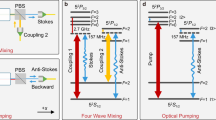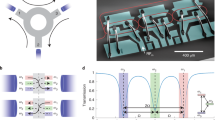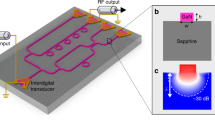Abstract
Optical isolators today are exclusively built on magneto-optic principles but are not readily implemented within photonic integrated circuits. So far, no magnetless alternative1,2,3,4,5,6,7,8,9,10,11,12,13,14,15,16,17,18,19,20,21,22 has managed to simultaneously combine linearity (that is, no frequency shift), linear response (that is, input–output scaling), ultralow insertion loss and large directional contrast on-chip. Here we demonstrate an electrically driven optical isolator design that leverages the unbeatable transparency of a short, high-quality dielectric waveguide, with the strong attenuation from a critically coupled absorber. Our concept is implemented using a lithium niobate racetrack resonator in which phonon-mediated13 photonic Autler–Townes splitting10,16,23,24 breaks the chiral symmetry of the resonant modes. We demonstrate isolators at wavelengths one octave apart near 1,550 nm and 780 nm, fabricated from the same lithium-niobate-on-insulator wafer. Linear isolation is demonstrated with simultaneously <1 dB insertion loss, >39 dB contrast and 10 dB bandwidth up to ~200 MHz.
This is a preview of subscription content, access via your institution
Access options
Access Nature and 54 other Nature Portfolio journals
Get Nature+, our best-value online-access subscription
$29.99 / 30 days
cancel any time
Subscribe to this journal
Receive 12 print issues and online access
$209.00 per year
only $17.42 per issue
Buy this article
- Purchase on Springer Link
- Instant access to full article PDF
Prices may be subject to local taxes which are calculated during checkout




Similar content being viewed by others
Data availability
The data that support the findings of this study are available from the corresponding author upon reasonable request.
Code availability
All relevant code is available from the corresponding author upon reasonable request.
References
Hwang, I. K., Yun, S. H. & Kim, B. Y. All-fiber-optic nonreciprocal modulator. Opt. Lett. 22, 507–509 (1997).
Kang, M. S., Butsch, A. & Russell, P. S. J. Reconfigurable light-driven opto-acoustic isolators in photonic crystal fibre. Nat. Photon. 5, 549–553 (2011).
Doerr, C. R., Dupuis, N. & Zhang, L. Optical isolator using two tandem phase modulators. Opt. Lett. 36, 4293–4295 (2011).
Lira, H., Yu, Z., Fan, S. & Lipson, M. Electrically driven nonreciprocity induced by interband photonic transition on a silicon chip. Phys. Rev. Lett. 109, 033901 (2012).
Tzuang, L. D., Fang, K., Nussenzveig, P., Fan, S. & Lipson, M. Non-reciprocal phase shift induced by an effective magnetic flux for light. Nat. Photon. 8, 701–705 (2014).
Li, E., Eggleton, B. J., Fang, K. & Fan, S. Photonic Aharonov–Bohm effect in photon–phonon interactions. Nat. Commun. 5, 3225 (2014).
Sounas, D. L. & Alù, A. Angular-momentum-biased nanorings to realize magnetic-free integrated optical isolation. ACS Photon. 1, 198–204 (2014).
Dong, C.-H. et al. Brillouin-scattering-induced transparency and non-reciprocal light storage. Nat. Commun. 6, 6193 (2015).
Kim, J., Kuzyk, M. C., Han, K., Wang, H. & Bahl, G. Non-reciprocal Brillouin scattering induced transparency. Nat. Phys. 11, 275–280 (2015).
Kim, J., Kim, S. & Bahl, G. Complete linear optical isolation at the microscale with ultralow loss. Sci. Rep. 7, 1647 (2017).
Ruesink, F., Miri, M.-A., Alù, A. & Verhagen, E. Nonreciprocity and magnetic-free isolation based on optomechanical interactions. Nat. Commun. 7, 13662 (2016).
Fang, K. et al. Generalized non-reciprocity in an optomechanical circuit via synthetic magnetism and reservoir engineering. Nat. Phys. 13, 465–471 (2017).
Sohn, D. B., Kim, S. & Bahl, G. Time-reversal symmetry breaking with acoustic pumping of nanophotonic circuits. Nat. Photon. 12, 91–97 (2018).
Kittlaus, E. A., Otterstrom, N. T., Kharel, P., Gertler, S. & Rakich, P. T. Non-reciprocal interband Brillouin modulation. Nat. Photon. 12, 613–619 (2018).
Peterson, C. W., Kim, S., Bernhard, J. T. & Bahl, G. Synthetic phonons enable nonreciprocal coupling to arbitrary resonator networks. Sci. Adv. 4, eaat0232 (2018).
Shi, Y., Lin, Q., Minkov, M. & Fan, S. Nonreciprocal optical dissipation based on direction-dependent Rabi splitting. IEEE J. Sel. Topics Quantum Electron. 24, 1–7 (2018).
Sohn, D. B. & Bahl, G. Direction reconfigurable nonreciprocal acousto-optic modulator on chip. APL Photon. 4, 126103 (2019).
Tian, H. et al. Hybrid integrated photonics using bulk acoustic resonators. Nat. Commun. 11, 3073 (2020).
Sarabalis, C. J. et al. Acousto-optic modulation of a wavelength-scale waveguide. Optica 8, 477–483 (2021).
Dostart, N., Gevorgyan, H., Onural, D. & Popović, M. Optical isolation using microring modulators. Opt. Lett. 46, 460–463 (2021).
Kim, S., Sohn, D. B., Peterson, C. W. & Bahl, G. On-chip optical non-reciprocity through a synthetic Hall effect for photons. APL Photon. 6, 011301 (2021).
Kittlaus, E. A. et al. Electrically driven acousto-optics and broadband non-reciprocity in silicon photonics. Nat. Photon. 15, 43–52 (2021).
Peng, B., Özdemir, Ş. K., Chen, W., Nori, F. & Yang, L. What is and what is not electromagnetically induced transparency in whispering-gallery microcavities. Nat. Commun. 5, 5082 (2014).
Zhang, M. et al. Electronically programmable photonic molecule. Nat. Photon. 13, 36–40 (2019).
Bi, L. et al. On-chip optical isolation in monolithically integrated non-reciprocal optical resonators. Nat. Photon. 5, 758–762 (2011).
Ghosh, S. et al. Ce:YIG/silicon-on-insulator waveguide optical isolator realized by adhesive bonding. Opt. Express 20, 1839–1848 (2012).
Huang, D. et al. Dynamically reconfigurable integrated optical circulators. Optica 4, 23–30 (2017).
Zhang, C., Dulal, P., Stadler, B. J. H. & Hutchings, D. C. Monolithically-integrated TE-mode 1D silicon-on-insulator isolators using seedlayer-free garnet. Sci. Rep. 7, 5820 (2017).
Du, Q. et al. Monolithic on-chip magneto-optical isolator with 3 dB insertion loss and 40 db isolation ratio. ACS Photon. 5, 5010–5016 (2018).
Zhang, Y. et al. Monolithic integration of broadband optical isolators for polarization-diverse silicon photonics. Optica 6, 473–478 (2019).
Yan, W. et al. Waveguide-integrated high-performance magneto-optical isolators and circulators on silicon nitride platforms. Optica 7, 1555–1562 (2020).
Maayani, S. et al. Flying couplers above spinning resonators generate irreversible refraction. Nature 558, 569–572 (2018).
Scheucher, M., Hilico, A., Will, E., Volz, J. & Rauschenbeutel, A. Quantum optical circulator controlled by a single chirally coupled atom. Science 354, 1577–1580 (2016).
Spencer, D. T. et al. An optical-frequency synthesizer using integrated photonics. Nature 557, 81–85 (2018).
Lucas, E. et al. Ultralow-noise photonic microwave synthesis using a soliton microcomb-based transfer oscillator. Nat. Commun. 11, 374 (2020).
Poulton, C. V. et al. Coherent solid-state LIDAR with silicon photonic optical phased arrays. Opt. Lett. 42, 4091–4094 (2017).
Del’Haye, P. et al. Optical frequency comb generation from a monolithic microresonator. Nature 450, 1214–1217 (2007).
Hummon, M. T. et al. Photonic chip for laser stabilization to an atomic vapor with 10−11 instability. Optica 5, 443–449 (2018).
Knappe, S. et al. A microfabricated atomic clock. Appl. Phys. Lett. 85, 1460–1462 (2004).
Newman, Z. L. et al. Architecture for the photonic integration of an optical atomic clock. Optica 6, 680–685 (2019).
Peng, B. et al. Parity-time-symmetric whispering-gallery microcavities. Nat. Phys 10, 394–398 (2014).
Gong, S. & Piazza, G. Design and analysis of lithium–niobate-based high electromechanical coupling RF-MEMS resonators for wideband filtering. IEEE Trans. Microw. Theory Techn. 61, 403–414 (2013).
Riedel, M. F. et al. Atom-chip-based generation of entanglement for quantum metrology. Nature 464, 1170–1173 (2010).
Blanshan, E., Rochester, S. M., Donley, E. A. & Kitching, J. Light shifts in a pulsed cold-atom coherent-population-trapping clock. Phys. Rev. A 91, 041401 (2015).
Tian, H. et al. Magnetic-free silicon nitride integrated optical isolator. Preprint at https://arxiv.org/abs/2104.01158 (2021).
Acknowledgements
This work was sponsored by the Defense Advanced Research Projects Agency (DARPA) grant FA8650-19-2-7924, the National Science Foundation EFRI grant EFMA-1641084 and the Air Force Office of Scientific Research (AFOSR) grant FA9550-19-1-0256. G.B. additionally acknowledges support from the Office of Naval Research (ONR) Director for Research Early Career grant N00014-17-1-2209 and the Presidential Early Career Award for Scientists and Engineers. D.B.S. acknowledges support from a US National Science Foundation Graduate Research Fellowship. We also thank K. Chow at the Holonyak Micro & Nanotechnology Lab (HMNTL) at the University of Illinois for valuable advice and guidance. The US Government is authorized to reproduce and distribute reprints for Governmental purposes notwithstanding any copyright notation thereon. The views and conclusions contained herein are those of the authors and should not be interpreted as necessarily representing the official policies or endorsements, either expressed or implied, of DARPA or the US Government.
Author information
Authors and Affiliations
Contributions
D.B.S., O.E.Ö. and G.B. jointly conceived the isolator concept. D.B.S. and O.E.Ö. performed the device fabrication, conducted the experimental measurements and analysed the data. All the authors contributed to writing the paper. G.B. supervised all aspects of this project.
Corresponding author
Ethics declarations
Competing interests
The authors declare no competing interests.
Additional information
Peer review information Nature Photonics thanks Chun-Hua Dong and the other, anonymous, reviewer(s) for their contribution to the peer review of this work.
Publisher’s note Springer Nature remains neutral with regard to jurisdictional claims in published maps and institutional affiliations.
Supplementary information
Supplementary Information
Supplementary Figs. 1–5, discussion and Tables 1 and 2.
Rights and permissions
About this article
Cite this article
Sohn, D.B., Örsel, O.E. & Bahl, G. Electrically driven optical isolation through phonon-mediated photonic Autler–Townes splitting. Nat. Photon. 15, 822–827 (2021). https://doi.org/10.1038/s41566-021-00884-x
Received:
Accepted:
Published:
Issue Date:
DOI: https://doi.org/10.1038/s41566-021-00884-x
This article is cited by
-
Quadrature nonreciprocity in bosonic networks without breaking time-reversal symmetry
Nature Physics (2023)
-
Integrated electro-optic isolator on thin-film lithium niobate
Nature Photonics (2023)
-
A heterogeneously integrated lithium niobate-on-silicon nitride photonic platform
Nature Communications (2023)
-
Direct extraction of topological Zak phase with the synthetic dimension
Light: Science & Applications (2023)
-
Integrated passive nonlinear optical isolators
Nature Photonics (2023)



